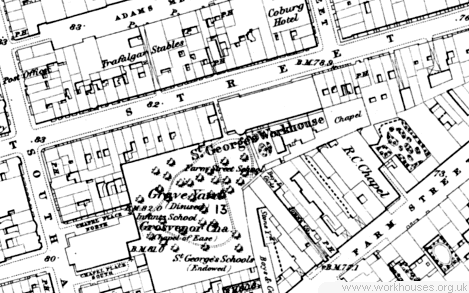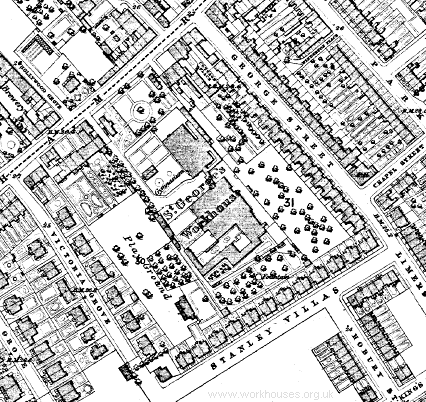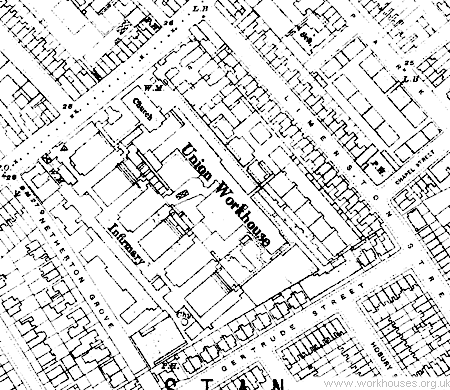St George's Hanover Square, Middlesex, London
Up to 1834
A parish workhouse for St George's Hanover Square was erected in 1726 at a site on the south side of Mount Street (on the ground now occupied by 103, Mount Street). Designed by Thomas Phillips and Benjamin Timbrell, the three-storey building, rather plain in appearance, had a street frontage of around 160 feet (48 metres). On the ground floor it had a work-room at the centre, and dining-rooms and charity schools for each sex in the wings. There was living/sleeping accommodation for 150-200 people on the upper two floors. The building was enlarged in 1743, and again in 1772 when as many as 600 paupers were in residence, with three or four sharing a bed. In 1786-8 the building was further enlarged with a watch-house being added at the western end.
In 1732, the second edition of An Account of Several Workhouses... included the following report of St George Hanover-Square.
IN the Year 1729, 187 Persons were lodged and dieted in the House, and at this time, April 1731. there are 155 Men, Women, and Children, of which last there are 85, under 13 Years of Age.
ALL that are able, both old and young, are employed in spinning Mop Yarn, or picking Ockam, and being helpful to each other under the Direction of the Steward and Matron; and the frugality of their Management, under the Honourable Persons, their present Churchwardens, and Overseers, is such, that at a Medium of their Expences for 1730, 154 Poor were lodged and dieted 4 Weeks at 55l. 1s. 7d. which is 1s. 9d. ½ a Week for each Person.
A Committee is appointed every Easter, composed of some Vestrymen, the Churchwardens and Overseers, who meet every Wednesday to regulate and manage the House, where the Tradesmen's Bills are paid once a Month.
THE Sick are taken Care of by an able Physician, an Apothecary, and Surgeon, who attend daily, and so well nursed in a part of the House appropriated for an Infirmary, that few have died out of great Numbers of small Children, and of other Persons that have had the Small-Pox, Fevers, and other Distempers.
A Clergyman attends to visit the Sick, and read Prayers twice a Week, and all that are able go to Church every Lord's Day.
THE Children are taught to read, write, and say their Catechism certain Hours of the Day, beside being inured to Labour, so as to prepare them for being good Servants wherever the Providence of God may dispose them, and several of them are bound to good Trades.
THE Parish-Officers, by their good Oeconomy, out of a Rate of 20d. in the Pound for the whole Year, saved a Balance of 750l. last Year, towards paying off the Debts contracted by erecting this Fabrick, and other Provision for the Poor.
In 1753, the Saint George's Hanover Square (Poor Relief) Act (26 Geo. 2, c.97) gave the parish special local powers relating to matters such as poor relief, street cleaning and road repairs.
A parliamentary report of 1777 recorded that the St George Hanover Square workhouse could accommodate 700 people, making it one of the largest in the country.
The Mount Street workhouse site location and layout are shown on the 1870 map below.

St George's Hanover Square, Mount Street site, 1870.
In 1786-88, the Mount Street premises were enlarged and additional premises, known as Shaftesbury House, were acquired in Little Chelsea to house children and lunatics.
After 1834
The parish's Local Act status exempted it from many of the provisions of the 1834 Poor Law Amendment Act and the existing arrangements for poor relief continued.
In 1841, a visitor described his experience of the Mount Street workhouse:
It consists of a very extensive building of four storeys, but without any exterior distinction in the line of street. The different wards with rows of beds, the spacious corridors and staircases, the airing grounds behind — all were neat, clean, and unexceptionable. In some workhouses off the back courts, the able-bodied inmates were employed in cutting up wood into faggots and doing other light work. In one of the upper floors, there is a drug dispensary for the house, with a young surgeon in attendance. During this visit, I received much greater insight into the economy of the new in comparison with the old system than on any former occasion; and I beg to tell what I know, for the benefit of those who take an interest in such matters. While the old wasteful practice existed of administering out-of-door relief to able-bodied, real or pretended, paupers, the parish of St George's, with a population of about 60,000, expended on the poor, police, and county rates, upwards of £61,000 annually. In 1835, when the new practice was introduced, the sum expended was only £39,000, being a diminution of one-third. Out-of-door allowances were still made in cases deemed necessary, but the great principle acted upon was to invite paupers to reside in the workhouse. As in all other parishes, this plan of relief at once checked a monstrous abuse; the claimants of the parochial bounty were thrown upon their own resources, and compelled to betake themselves to industrial pursuits. I was informed that the consideration of out-of door cases for casual relief, which once occupied two days a-week to the board of directors, was now dispatched in an hour, and that he did not believe there was a destitute person unprovided for in the parish. All fit objects of public support (certain cases always excepted) are now admitted either into the house in Mount Street, or into another establishment at Chelsea. At the period of my visit, the inmates were as follows:— At Mount Street, 117 men, 211 women, 15 boys, and 17 girls — in all 360; at Chelsea, 25 men, 110 women, 91 boys, and 54 girls — in all, 280; lunatics at Hanwell asylum, 50; children at nurse, 1; total, 691. Having inquired if the men who applied at the workhouse belonged to any particular profession or class of society, it was mentioned, that there was usually a large proportion of decayed footmen or other domestic servants; but whether this may be considered an indication of improvident habits on the part of that class of persons, or of the misfortune of their condition, I am unable to say.
Little Chelsea Workhouse, Fulham Road
On 14 July 1853, the foundation stone was laid for a new workhouse being erected at the parish's Little Chelsea site on Fulham Road. Below is a report on the new premises from September 1856.
On Thursday last a party of the parishioners went over the recently-erected workhouse at Little Chelsea, for the purpose of inspection. They were accompanied by Dr. Brewer and Messrs. Englefield, Payne, and Peal, members of the house committee of the poor board, Mr. and Mrs. Baber, the master and matron, who gave the visitors the most ample information as to the present condition of the establishment. Everything appeared in the best order, and the inmates were found to be in good health and spirits. The most interesting point in the inspection was the excellent accommodation afforded for the aged married couples. This has been attained instrumentally through the exertions of Mr. Englefield and Dr. Brewer. Every department was found to be in good working order, the provisions of the best description, and the attention of the master and matron to their respective duties of a very exemplary character. The building is erected on the site of a mansion formerly the residence of the Earl of Shaftesbury; and in the tool-house, now standing in the garden, Locke wrote a great portion of his "Essay on the Human Understanding." It is arranged for the reception of female paupers, children, and married couples, as part of an ultimate plan, which will include the male paupers now accommodated in Mount-street during the unexpired term of the present lease. The school building has accommodation for 300 children. It has a lofty and spacious boys' and girls' school, also used as a chapel for the whole establishment, including the adults; the infants' school and dormitory, with airing ground attached; lofty and spacious dining room, lavatories, bath rooms, boys' and girls' sculleries, and workshops for shoe-makers and tailors; large separated airing grounds, with apparatus for gymnastic exercises connected with the schools of the respective sexes, and overlooked and commanded by the schoolmasters' and schoolmistresses' apartments, which also are placed between the staircases and dormitories of the boys and girls. The dormitories, schools, and dining-hall are warmed by open fires. A thorough ventilation is effected by luffers, panels in the respective fronts, with open troughs in the thickness of the floor, with two shutters in the ceiling, in each ward, lowered or raised as the temperature may require; with perforated zinc sides for the divisional distribution of the pure external air — the ventilation being carried on by the supply entering by the shutter nearest the windward luffer, and passing out by the leeward shutters and luffers. By this division and distribution the partial draughts are avoided. The new workhouse for the female paupers is connected with the schools by a covered way. The present part of it is built for the accommodation of 365 female paupers, with power of extension. The arrangements for cooking, washing, drying, ironing, &c., are completed for 1,200 inmates, and the married couples. The master's office commands the entrance. The inmates are divided into classes, namely, able-bodied, suckling wards, infirm, bedridden, infectious and infirmary cases. These are again subdivided, and have each their separate airing grounds, in each of which there is a work room, lavatory, waterclosets, &c, and a refractory ward. The airing grounds are overlooked and commanded by the matron's and master's private apartments. The central position of the master and matron also controls every ward within the establishment. The cubic and superficial area of every ward is governed by the maximum scale of the Poor-law Commissioners. The classes never come into contact, but proceed to their appropriate places; in the dining-hall to their meals, to their employment, or their dormitories. Each class has a separate staircase, with a portable bath, sink, with hot and cold water, and waterclosets on every floor. Every ward has an open fireplace, a gas lamp over the door, and a bell, in case of sickness, to ring to the master's and matron's apartments. The ventilation of the able-bodied wards is perfected by the fireplaces and ventilating shutters, by direct, natural, pure supply of air, as in the schools. The aged, infirm, and sick wards are perfected by a plenum ventilation, effected by steam batteries, giving a constant and unchecked supply of 7 cubic feet of pure atmospheric air per minute to each inmate, constantly flowing through the batteries. Each battery has upwards of 120 superficial feet of heating surface, the supply being at a temperature never exceeding 100 degrees — the vitiated air being extracted by zypha and other means equal to the supply. The temperature of the wards can be raised at pleasure to 60 or 68 degrees on the coldest days. The nurses are on each floor, placed between the infirm, bedridden, idiots, and infectious — the infectious being separated from the other inmates by a separate staircase. The medical officer and clergyman's rooms are on the same side. The steam-boiler house, cellars, larders, &c, are in the basement. The cookery, scullery, laundry, drying-room, wash-house, baths, with ample hot and cold supplies on the several floors, and the warming and ventilation are effected by a furnace for the whole establishment. The kitchen opens into the dining-hall, where is the master's circular dresser, on which all the meat and other rations are weighed and served in the sight of the inmates. The plates, trays, &c., when used are returned to the scullery. In the kitchen is a gas stove for roasting when required. In the laundry is a drying-room, mangles, Italian irons, heated by steam. It opens into the wash-house, which, unlike other wash-houses, has its coppers and rinsers in the middle, so that the women work all round them without, stooping, the steam ascending to the outlet direct — thus keeping the women dry in their work. The washing troughs have cold water and steam supplies to each, and could be raised to boiling in seven minutes; also centrifugal wringers. There is a drying ground attached. The married couples' department is prepared for 12 aged couples, exceeding each 60 years of age. Each couple have their separate dormitory, with a bell to each, separated lavatories and waterclosets at either end, with spacious corridors, warmed by steam to a temperature of 60 degrees in winter. They have a spacious lofty day room, with large open fireplace in common, with two arm chairs and a table to each couple, and closets for their books, &c. They have also a large garden, well planted, as an airing ground. It is not possible to enter into the minutiae of every part of the establishment in this description; but it may be observed that the whole practically works well and perfect, and that the control over every part is entirely satisfactory to the master and matron, house committee and the governors and directors of the poor. The style of the building is after the old English country mansion, massive and substantial, without superfluous ornament of any kind and reflects great credit to the architect, Robert W. Jerrard, Esq., of Pimlico. The party, after having expressed themselves much gratified with what they had seen, and thanking Mr. Englefield and his colleagues for their courtesy and attention on the present occasion, departed. Mr. Englefield is desirous of forming a library for the aged inmates, and would feel thankful for some old books, magazines, &c., for that purpose.

St George's Hanover Square, Fulham Road site, 1874.
In 1870, St George's Hanover Square parish became part of the new St George's Union, along with the parish of St Margaret and St John the Evangelist. The new union took over the existing workhouses. The Fulham Road site was much expanded in 1876-8 with the erection of a large new infirmary. The Mount Street site appears to have closed soon afterwards and the buildings were demolished in 1886 as part of a major redevelopment of the area.

St George's Hanover Square, Fulham Road site, 1915.
Further information on the Fulham Road site is given on the St George's Union web page.
In January 1871, The Builder reported that the Guardians of St George Hanover Square (apparently still in existence) had agreed to the erection of a temporary iron smallpox hospital at St Ermin's Hill, Broadway, Westminster. The building was to be 130 feet by 20 feet and would accommodate 40 patients.
Staff
Inmates
- Long-term Mount Street workhouse inmates (1861)
- Long-term Little Chelsea workhouse inmates (1861)
- 1881 Census — Mount Street workhouse
Records
Note: many repositories impose a closure period of up to 100 years for records identifying individuals. Before travelling a long distance, always check that the records you want to consult will be available.
-
City of Westminster Archives Centre, 10 St Ann's Street, London SW1P 2DE.
- Pre-1870 parish records include: Governors and directors of the poor minutes (1753-1867, indexed 1780-1867); Overseers' accounts (1726-7); Workhouse committee minutes (1726-53); Workhouse visiting committee minutes (1861-7); Workhouse accounts (in vestry#churchwardens' records 1725-35); Workhouse admission and discharge records (1856-69); Minutes of committee re soup kitchen and schools of industry (1799-1803, 1833); Apprenticeship indentures (1738-42, 1752, 1767); etc.
- Post-1870 union records include: Fulham Road Workhouse: baptism registers (June 1879 - August 1900); Wallis's Yard Workhouse: baptism registers (January 1866 - December 1892)
-
The
Ancestry UK
website has two collections of London workhouse records (both name searchable):
- Westminster workhouse records are available on FindMyPast, .
-
London Metropolitan Archives, 40 Northampton Road, London EC1R OHB.
- Mount Street workhouse holdings include: Creed registers (1874-84); Register of children boarded-out (1871-1913).
- Fulham Road workhouse holdings include: Admissions and discharges (1866-1916); Births (1879-89); Baptisms (1900-07); Deaths (1870-1932); Master's journal: (1903-13); etc.
- Fulham Road infirmary holdings include: Baptisms (1878-86); etc.
- Other holdings include: Guardians' minute books (1870-1915); Financial records (1870-1921, with gaps); Staff records (1863-1914); etc.
Bibliography
- Higginbotham, Peter Workhouses of London and the South East (2019)
Links
Unless otherwise indicated, this page () is copyright Peter Higginbotham. Contents may not be reproduced without permission.


